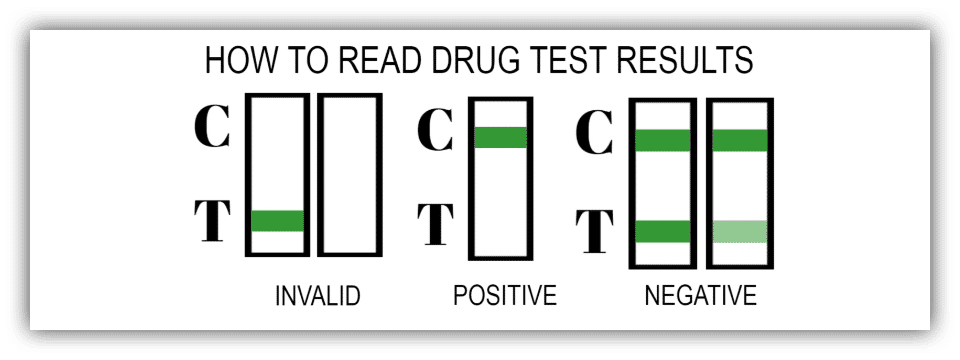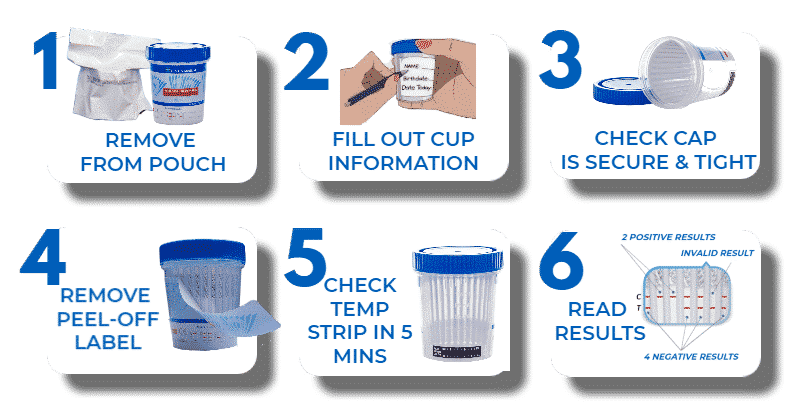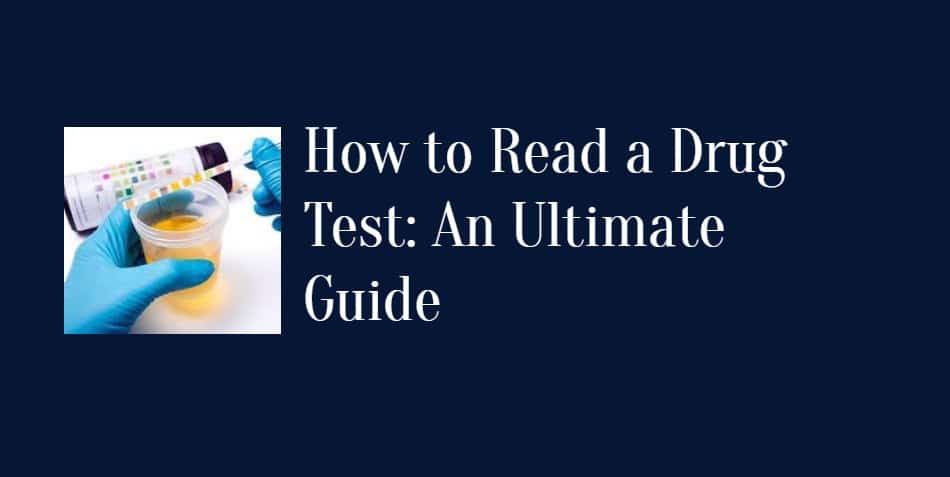Drug Test Guide
Have you ever looked at the results of a drug test and wondered what exactly they meant? Drug tests have a variety of uses, including pre-employment screening, compliance assessment, and substance abuse prevention at home. However, they can be more than a little confusing to read and interpret. Read this quick guide to discover how to read a drug test and interpret the results.
How to Read a Drug Test
All drug tests will have two regions on them. The first region is the Control or C Region. A Control Region measures if the drug test has worked correctly and is valid. If a colored line appears in the Control Region, the drug test is valid. But if a colored line does not appear in the Control Region the drug test is invalid.  Invalid tests typically occur because the drug test’s procedure was incorrectly done, there was not enough fluid to test, or the test was simply faulty. In the case that a colored line does not appear in the Control Region and the test is invalid, it is necessary to redo the test. The second region is the Test Region. The Test Region is the area that will inform if the person tested has drugs in their system or not.
Invalid tests typically occur because the drug test’s procedure was incorrectly done, there was not enough fluid to test, or the test was simply faulty. In the case that a colored line does not appear in the Control Region and the test is invalid, it is necessary to redo the test. The second region is the Test Region. The Test Region is the area that will inform if the person tested has drugs in their system or not.
A line will appear in the Test Region in the case of a negative result, meaning that the test did not detect any drugs. It does not matter if the line is faint or dark. As long as it appears, the drug that is being tested for is not present. If a line does not appear in the Test Region, this indicates a positive result. A positive result means that the drug being tested for is present in the person undergoing the test. In essence, you must have two lines appear on the drug test to be able to say that the person undergoing the test has received a negative result.
When no lines appear, it is necessary to redo the test. If the first line—marked by Control or C—does not appear, it is necessary to redo the test. Then if the second line—marked by Test or T—does not appear the drug being tested for is present.
How to Read a Drug Test Cup
A drug test cup, otherwise known as a urine drug test, is one of the most common methods to test for drugs. Drug test cups are used for a variety of purposes, including:
- Pre-employment and current employment screenings
- Home substance abuse prevention
- Criminal justice and law enforcement
- Rehabilitation centers
Drug test cups come in 6-panel, 8-panel, 10-panel, 12-panel, 13-panel, 14-panel and 16-panel tests. The more panels a drug test cup has, the more drugs the test will try to detect. See all multi-panel cups here. Just like other drug tests, cups will have a Control Region and Test Region, and it is necessary for colored lines to appear in both regions to test negative for drugs. Urine drug test cups typically also have a temperature strip.
These strips are designed to detect abnormalities in a urine sample’s temperature. If there are abnormalities in the urine’s temperature, it may imply the urine sample is either inauthentic or adulterated. An inauthentic urine drug test is when a person either brings in fake urine or urine obtained from another person. An adulterated urine drug test is when a person adds water or another substance to the urine to alter the result.
How to Read a Urine Drug Test Results
The main difference between reading the results of drug test cups from other drug tests is the addition of the temperature strip. Strips typically use color-based indicators to determine the temperature of the urine. Most urine drug tests can be read using the following instructions:
- Collect at least 30mL of urine in the drug test cup
- Wait for the green indicator to depict the temperature of the sample
- If the color of the indicator is blue, add 1 degree Fahrenheit to the temperature marked by the indicator
- If the color of the indicator is tan or brown, subtract 1 degree Fahrenheit from the temperature marked by the indicator
However, not all drug test cups follow these same instructions. To ensure you are reading the drug test results correctly, be sure to check any instructions that come with the kit. The temperature strip on urine drug tests should fall between 90 to 100°F. While human urine tends to range from 94 to 96°F, the urine sample’s temperature may change based on the ambient environment. If the temperature is below 90 degrees Fahrenheit or above 100 degrees Fahrenheit, this may mean the drug test has been tampered with. However, urine samples may also fall out of that temperature range if:
- The sample has direct exposure to sunlight
- The sample has exposure to temperatures above 131 degrees Fahrenheit
- The sample is read more than 4 minutes after it was received

Interpreting Results
Now that you know how to read a drug test, there are some important factors to consider when interpreting the results. Again, a faded colored strip has the same meaning as a vivid colored strip. Also, even if a person receives a negative result on a drug test, it does not necessarily mean they are completely drug-free, and even if a person receives a positive result on a drug test, there is the possibility that it is a false positive.
Cutoff Levels
Just because a drug test gives a negative result, that does not necessarily mean the person undergoing the drug test is completely free of drugs. Drug tests have a designated cutoff level, meaning people will only test positive if the amount of drugs in their system is higher than a certain amount. Cutoff levels exist to help prevent false positives from occurring. Depending on who is conducting the drug test and what drug is being tested, the cutoff levels may vary. Drug tests conducted in places of employment tend to have a standard set of cutoff levels, while law enforcement and rehab centers may use lower cutoff levels.
False Positives
Positive test results refer to when a drug is present in a person’s system. Above the cutoff level of the drug test. A person tests positive for drugs when one line appears in the Control region and no line appears in the Test region. When this occurs, you may want to use additional confirmatory drug testing to ensure that a false positive has not occurred. False positives often occur due to “imposter” substances, typically rooting from a prescription drug or food. Some common medications that can cause false positives are:
- Over-the-counter cough suppressants that include Dextromethorphan can cause a false positive for opiates and phencyclidine (PCP)
- Sudafed, which can result in a false positive for amphetamine or methamphetamine
- Anti-inflammatory pain medications containing ibuprofen and naproxen may cause a false positive for barbiturates and marijuana; ibuprofen can also cause a false positive for PCP
- Allergy medications that include the antihistamine Diphenhydramine can cause a positive result for opiates, methadone, or PCP
- Oxaprozin can cause a false positive for amphetamines
- Ritalin can result in a false positive for amphetamines,
- methamphetamines, or LSD
- Over-the-counter sleep aids that include doxylamine can cause a false positive for methadone or PCP
- Trandate can result in a false positive for amphetamine,
- methamphetamine, or LSD
- Glucophage can cause a false positive for amphetamine or methamphetamine
- Cardizem can result in a false positive for LSD
- Several antidepressants including Sertraline, Venlafaxine, Trazodone, and many more can result in false positives for a variety of different drugs
Because of this, those administering the drug test should ask about any prescription drugs or over-the-counter medications that the person undergoing the test may have taken. Administers of drug tests should also ask the person undergoing the test if they have ingested:
- Poppy seeds, which can cause a false positive for opioids
- Energy drinks and vitamin B12, which can result in a false positive for marijuana
- Kava, which can result in a false positive for MDMA
Reading Drug Tests
Now that you know how to read drug tests. Y
ou will be better able to understand the results of any drug test. Be sure to read any instructions that come with the drug test kit in order to ensure you are administering the test correctly. You may also want to double-check positive results, just in case one of them is a false positive. If you are looking for accurate, high-quality drug tests, be sure to take a look at our urine drug test cups. Purchase Drug Tests Here

